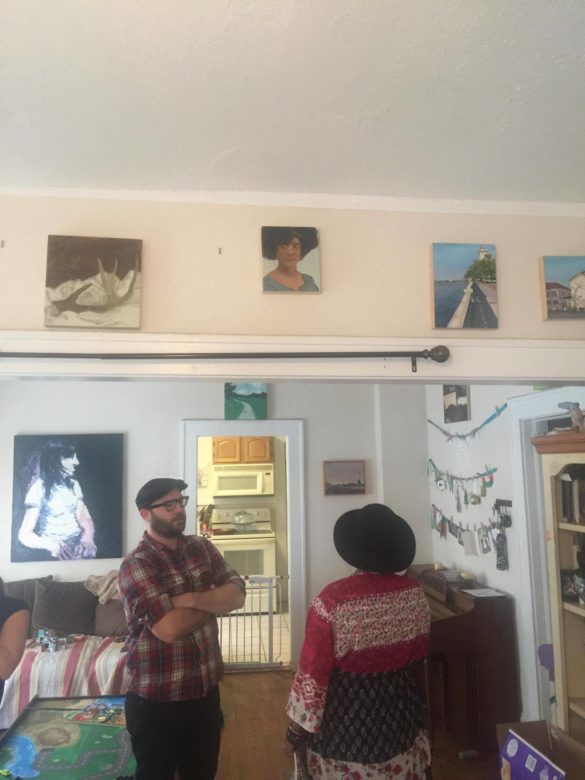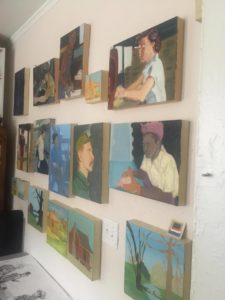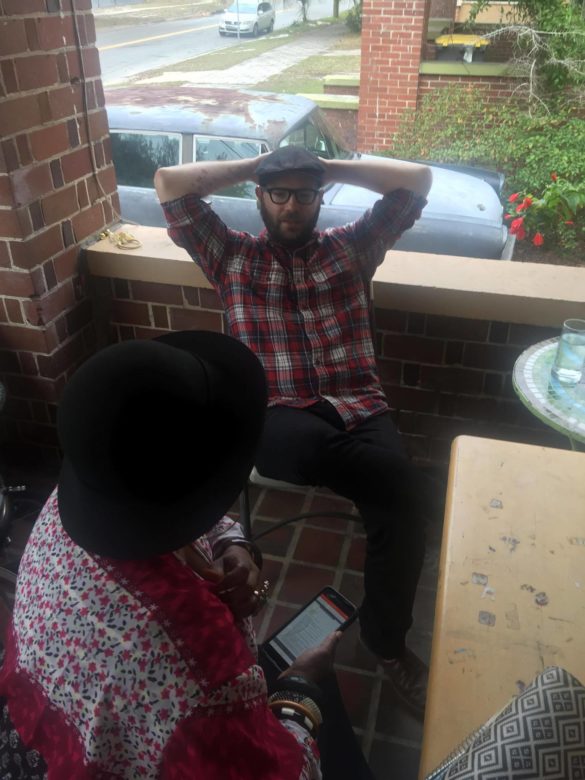As a way to continue the conversations around LIFT, the artists involved, and the content of the artwork, this series of blogs will be looking at the artists’ work moving forward, their future exhibitions, and the direction their artwork has taken since creating pieces for the LIFT exhibition.
WRITTEN BY SHAWANA BROOKS, GUEST CONTRIBUTOR
 The Rooms Where it Happens
The Rooms Where it Happens
Firmly nestled in one of Jacksonville’s esteemed boroughs, Springfield, all things are stirring around the house. Springfield is the home of Porchfest, a new mural, and soon two new breweries; it’s redeveloping. The neighborhood feels different, and Anthony Aiuppy, Thony to those who know him best, loves this area. He is proud to call Jacksonville his home. Thony’s home studio is marginally off limits to his beautiful children, who are currently demanding his attention. Melissa, a pianist and a teacher, is managing the chaos of expressive artistic children who range in ages. The oldest and youngest tinker around with the ivories showing off their skills, while Melissa and her middle child rest comfortably on their couch. Artists are all around, figuratively and literally, as the Auippys are quite the art collectors themselves.
Thony’s paintings are in good company on the walls. There are works of art from artists Steve Williams, Tom Hager, and Madeline Peck Wagner. “We don’t really have storage for paintings, so I just hang them around my house,” he says. Paintings cover their walls from the living room to the den and flow into their kitchen. The paintings in the place where he eats show Thony’s real hunger. He has been experimenting with his Worker Series.
Since September 26, 2016 he’s been doing weekly art classes with children. He does not deny he has been influenced; he is elated by the full circle of now being in an exhibition (LIFT) with his former and favorite art professor, Dustin Harewood. He is upping his technique. More colorful backgrounds are occurring than the muted palette he has been establishing as his signature style. It feels exciting and new, but still Thony. He’s marrying his Southern Gothic narrative to his Worker Series.
“I know what it’s like to work a graveyard shift. I didn’t go to college until I was 25. My creative process comes from my background in manual labor. Making art is a manual labor job.”
The physicality in artmaking is always there. Yet it is not the perception. [Artists are still lampooned as if they are young men in Paris, sitting idly, and drawing beautiful women.] In Thony’s truth it is more like being a blue-collar worker. There is physical labor that goes into using the tools to building frames, stretching canvases, and mounting them down. “There’s a lot of sweat and blood.”

Don’t Stop ‘Til You Get Enough
The father of three is already focused on his artwork for 2018. “I am going to continue my theme with the ‘Workers’, but more like in the narrative form, like the paintings from the Cummer Museum.” His smaller works are snapshots of that southern living, and paintings like the ones in LIFT, let him give a fuller narrative to his art. “I like the way that both of them work. It kind of fills in the space. There is something going on in that space.”
 At the time of this interview, Thony was getting ready for two shows, one solo. In the exhibition Till We Have Faces at the Karpeles Manuscript Museum, he will be revisiting more than 50 of his paintings. The other is a group show, A More Perfect Union: Explorations for Human Rights, which opened February 3 at the Space Gallery. Thony loves the idea of displaying art close to home. A mixture of southern landscapes, plantation houses, drawings, and his Worker series will line the walls of the Karpeles, while in A More Perfect Union, he will be reunited in displaying art with fellow LIFT artists Overstreet Ducasse, Princess Simpson Rashid, Chip Southworth, and Roosevelt Watson III. By the end of February all three shows will come down.
At the time of this interview, Thony was getting ready for two shows, one solo. In the exhibition Till We Have Faces at the Karpeles Manuscript Museum, he will be revisiting more than 50 of his paintings. The other is a group show, A More Perfect Union: Explorations for Human Rights, which opened February 3 at the Space Gallery. Thony loves the idea of displaying art close to home. A mixture of southern landscapes, plantation houses, drawings, and his Worker series will line the walls of the Karpeles, while in A More Perfect Union, he will be reunited in displaying art with fellow LIFT artists Overstreet Ducasse, Princess Simpson Rashid, Chip Southworth, and Roosevelt Watson III. By the end of February all three shows will come down.
Working Day and Night
“An hour in the morning is worth two in the evening” – Chinese Proverb
A friend recently inquired about how he juggles it all – “It doesn’t feel like it’s a lot when you are doing your calling.” Thony credits the Cultural Council for allowing him to take the Creative Capital workshop. Out of it he developed some creative planning skills. “That really helped me to schedule and maximize the time I have,” he said. Thony would rather paint in the morning rather than at night, the time where most artists thrive, but he knows that’s when he needs to be resting.
“We plan our lives. We have a family monthly calendar. I have a weekly planner and then within it I have a daily calendar, so I know what days I have studio time and I know what days I have a date night, and I know like, family.”
As the coffee maker goes off in the morning, “I hear that thing, I’m up. I’m awake, alert, and I got coffee.”
Even his studio time is well-calculated, “From about 5 or 5:30 a.m. to 7:30 or 8:00 a.m., that’s studio time.” He lives by his own adage, “If you don’t plan it, I don’t think you will be able to do much.” And there isn’t much Thony isn’t doing. Not only is he in a successful and nationally-recognized exhibition, he himself was recently acquired by the Museum of Contemporary Art in Jacksonville, as the J. Wayne and Delores Barr Weaver Educator. This is where Thony has shifted his focus. Less nostalgia than necessity has Thony seeing Jacksonville as one big “Choose Your Own Adventure” book.
His choice is for the Downtown Core to become the main place for arts education integration; he’d love art to be a focused core subject. STEM is picking up STEAM, and if you are on Laura Street on a weekday, you will see yellow school buses filled with curious children flooding the doors of MOCA being welcomed by “The Weaver” educator. At 36, teaching is Thony’s true calling.
“They made a mistake in the 70s and now they are like arts should be core subjects and they are cramming it down kids throats! You have a whole generation of adults in this city who never ever got arts education. It was stripped from schools, there were no field trips.”
Art appreciation has to be taught and developed; what happens when those adults have children? Most don’t have cultural context to identify how the arts could affect the community. The arts are viewed as soft subjects or inferior; this can be your perspective if your exposure to art was taking a liberal arts class to pass your undergraduate studies. Arts aren’t valued and artists even less as Thony sees the issue, “There’s a problem here!” There was an incident recently at MOCA where a photo was viewed as indecent. The community came out and showed their support and stood with MOCA, which rolled into a believing-in-MOCA campaign. Thony’s belief is that incidents like this can be tempered in the future by more art education.
“I like educating kids, but also adults. Part of teaching to me is to equip parents so that if they don’t know a style or certain artists, they won’t be dismissive of art.”
That might be the most important thing Thony will ever do for the city, “Like ever!”
You Betta Work
“Our city has no identity,” says Thony. He knows there is no perfect solution to fixing this problem… well maybe one. “Stick around instead of just dipping out. OK. Instead of trying to go to a larger market where the resources are tapped out, stay here. Yes there are some hoops, but you can basically do whatever you want to do creatively.” There is this perception of Jacksonville being a big little town or the next big city. He is preaching to the choir, “This city has opportunities, but you have to get to the point where you make your own.” Thony is beyond committed to making this a better community. “I’m in place I would have never thought I would be last year,” referring to his new gig at MOCA.
In 2015, Thony was hustling, he had several exhibitions, “I was creating a ton of work.” He was teaching adult classes, teaching at Reddi Arts, art camps, and at University of North Florida. He wasn’t satisfied, but he kept pushing. Being a demonstrating artist with the Cummer Museum, especially during the VSA Festival had its privileges.
He was affected by teaching in communities where poverty is abundant but not always evident. When your socioeconomic status is light your awareness of that can be dulled by your environment. He learned a lot working with those students. “I didn’t know not to say boy.” It was a learning lesson for all. It made his intensity for justice grow deeper. He is trying to live by the words of MLK by not judging someone by the color of their skin but the content of their character.
 You can see that in the work in LIFT, particularly in the piece Stony the Road. It was at one of those “hustling” exhibitions where then Cummer Museum Director Hope McMath gave him the beginnings of what LIFT would be. She vocalized her intention for his work to be a part of the exhibition. Maybe that is why Thony was one of the first artists to fully complete his work. At the shared meeting of participating artists, all were dumbstruck around the room when he voiced he was finished. Most of the artists were in the middle of their works, and one had not even begun.
You can see that in the work in LIFT, particularly in the piece Stony the Road. It was at one of those “hustling” exhibitions where then Cummer Museum Director Hope McMath gave him the beginnings of what LIFT would be. She vocalized her intention for his work to be a part of the exhibition. Maybe that is why Thony was one of the first artists to fully complete his work. At the shared meeting of participating artists, all were dumbstruck around the room when he voiced he was finished. Most of the artists were in the middle of their works, and one had not even begun.
He is under no allusion that Jacksonville will be adopting these thought processes anytime soon. As an exhibiting artist he knows the necessity of doing exhibitions outside of your city. But you will not hear him bad-mouthing Jacksonville in the process. A very audible voice came to Thony while at church off of McDuff Avenue. It said, “You need to be for the city.” It freaked him out and rightly so. Ever since graduating from Savannah College of Art and Design, he has tried to leave Jacksonville. The old mafia cliché wouldn’t turn him loose; he was locked in. His belief is that as a society we place an intrinsic value on art but not on financially providing sustainability. He recounts a story of a gallery (X Nylo) where he used to help curate shows and provide the necessary resumé-building skill of exhibiting artists in Springfield. “I loved doing that, providing opportunities for artists. But dollars… money.” It’s no secret that galleries are hard to sustain here. The collector’s list is short, and the perception again is people think they cannot afford to buy artwork. “There is no market, unless your gallery is also attached to a frame shop.” The gallery had two seasons and then ran out of resources. “Shops close up. You have to have the lights on and have a key for someone to see your stuff.”
This is the reality. There are artists here short-selling others but that goes with educating. Thony is ready to teach.
“I could go anywhere I want to, but here I get to stay and I get to play, and I have a part to make something happen. I’m here to live, work, and make cool stuff.”
Thony knows he is being called; Jacksonville needs an Ambassador to say, “I am staying here,” but who?
Greatest Love of All
The assimilation of a general blanketed whiteness in America has denigrated the Sicilian heritage of the Auippy name, “It originally had an “a” at the end, but at Ellis Island they Amercanized it, and put a y.” Auippa no more. This country has had a long history at removing culture and heritage by attaching last names to its non-citizens. Some are immigrants, others were forced into assimilation never having the opportunity to immigrate; forced to continue to bear the name of their former oppressors as now inclusionary citizens. America’s history has never been as shiny as we would like to remember it. “They actually mention my Great Uncle in the movie Casino ‘Joey Doves.’ I’ve got it bad on both sides. On my Mom’s side I’m like 16th-generation descendant of Jessie James. Bad blood. But we don’t talk about that,” he laughs. Yes family history is complicated and rarely do we like discussing our faults.
Museums can be safe spaces to engage these difficult topics. The background of art opens the viewer up to feelings that are often not vocalized. It’s why Thony appreciates the programming the Cummer Museum has offered during the run of LIFT. It’s in one of these programs he forged a deeper bond with artists Ingrid Damiani, Princess Simpson Rashid, and Roosevelt Watson III. “I gained two sisters and a brother.” They performed under the tutelage of Folio Weekly’s Best Actress of 2016, Barbara Colaciello. Thony reflects on how this exhibition changed his world and his view of community. Not only do you need an “I” but you need a “U” for community.
“I think that [Martin Luther] King hits it, and I personally aspire to it; I want it to be my default. I love people. I hope people are honest enough when I’m being a jerkface. Some of the LIFT stuff is unconscious bias, but YOU have to learn from that.”
Museums and libraries are learning how to help people curate those conversations. Barbara Colaciello will again weave something together for the closing day of the exhibition to be held on February 12, 2017. Too often, Black heritage is told by others, who shape the narrative based on their perspective, creating an inauthentic view of our collective history. Though contemporary elements are necessary to help redevelop that intention, it is good to reach out to the greater community and ask a question before assuming you have the answer. As LIFT is getting closer to lifting off, other exhibitions around the city, like the black-women-centric-focused exhibition KESHA: A Black Female Experience of Identity and Race, at the Main Library in the JMS Gallery on the 1st floor, will continue those conversations. It will be interesting to see how Jacksonville will be viewed in a few months. History is happening here all the time. Thony hopes to see more progression and inclusion. He is focused on birthing new collectors. The children of today will be his future,
“That’s why I’m in the job I’m at. I am on a mission to provide more opportunities for families to get engaged in the cultural world around us, mainly through Contemporary Art. It’s the most diverse.”




Fabulous Interview and insights. What a great guy and artist. Thank you for this glimpse of process, purpose and perspective.